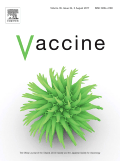Ver ítem
- xmlui.general.dspace_homeCentros e Institutos de InvestigaciónCICVyA. Centro de Investigación en Ciencias Veterinarias y AgronómicasInstituto de BiotecnologíaArtículos científicosxmlui.ArtifactBrowser.ItemViewer.trail
- Inicio
- Centros e Institutos de Investigación
- CICVyA. Centro de Investigación en Ciencias Veterinarias y Agronómicas
- Instituto de Biotecnología
- Artículos científicos
- Ver ítem
Transient expression of VP2 in Nicotiana benthamiana and its use as a plant-based vaccine against Infectious Bursal Disease Virus
Resumen
Infectious Bursal Disease Virus (IBDV) is the etiological agent of an immunosuppressive and highly contagious disease that affects young birds. This disease causes important economic losses in the poultry industry worldwide. The VP2 protein has been used for the development of subunit vaccines in a variety of heterologous platforms. In this context, the aim of this study was to investigate VP2 expression and immunogenicity using an experimental
[ver mas...]
Infectious Bursal Disease Virus (IBDV) is the etiological agent of an immunosuppressive and highly contagious disease that affects young birds. This disease causes important economic losses in the poultry industry worldwide. The VP2 protein has been used for the development of subunit vaccines in a variety of heterologous platforms. In this context, the aim of this study was to investigate VP2 expression and immunogenicity using an experimental plant-based vaccine against IBDV. We determined that the agroinfiltration of N. benthamiana leaves allowed the production of VP2 with no apparent change on its conformational epitopes. Chickens intramuscularly immunized in a dose/boost scheme with crude concentrated extracts developed a specific humoral response with viral neutralizing ability. Given these results, it seems plausible for a plant-based vaccine to have a niche in the veterinary field. Thus, plants can be an adequate system of choice to produce immunogens against IBDV.
[Cerrar]

Fuente
Vaccine 31 (23) : 2623-2627 (May 2013)
Fecha
2013-05-28
Editorial
Elsevier
ISSN
0264-410X
Formato
pdf
Tipo de documento
artículo
Palabras Claves
Derechos de acceso
Restringido
 Excepto donde se diga explicitamente, este item se publica bajo la siguiente descripción: Creative Commons Attribution-NonCommercial-ShareAlike 2.5 Unported (CC BY-NC-SA 2.5)
Excepto donde se diga explicitamente, este item se publica bajo la siguiente descripción: Creative Commons Attribution-NonCommercial-ShareAlike 2.5 Unported (CC BY-NC-SA 2.5)
Metadatos
Mostrar el registro completo del ítemÍtems relacionados
Mostrando ítems relacionados por Título, autor o materia.
-
Relative incidence of cucurbit viruses and relationship with bio-meteorological variables
Pozzi, Elizabeth Alicia; Bruno, Cecilia Inés; Luciani, Cecilia; Celli, Marcos Giovani; Conci, Vilma Cecilia; Perotto, Maria Cecilia (Springer, 2020-02)Environmental heterogeneity can shape the plant-virus relationship, furthering the appearance of new diseases in crops, or altering disease incidence and severity. In this work, we studied the virus association with ... -
Virosis en zapallito de tronco
Perotto, Maria Cecilia (EEA San Pedro, INTA, 2022)Las principales virosis que afectan al zapallito redondo son las producidas por virus del género Potyvirus. Hay 4 especies de este grupo presentes en Argentina, estos son: Watermelon mosaic virus (WMV), Zucchini yellow ... -
Enfermedades del Poroto
Ploper, Leonardo Daniel; González, Victoria del V.; Rodriguez Pardina, Patricia; Díaz, Cecilia G.; Vizgarra, Oscar Nicéforo (Asociación Argentina de Fitopatólogos, 2024)El género Phaseolus (familia Fabaceae) está compuesto por más de 70 especies botánicas originarias de Mesoamérica y América del Sur. Incluye varias especies de interés hortícola, entre las que se pueden mencionar P. vulgaris ...

